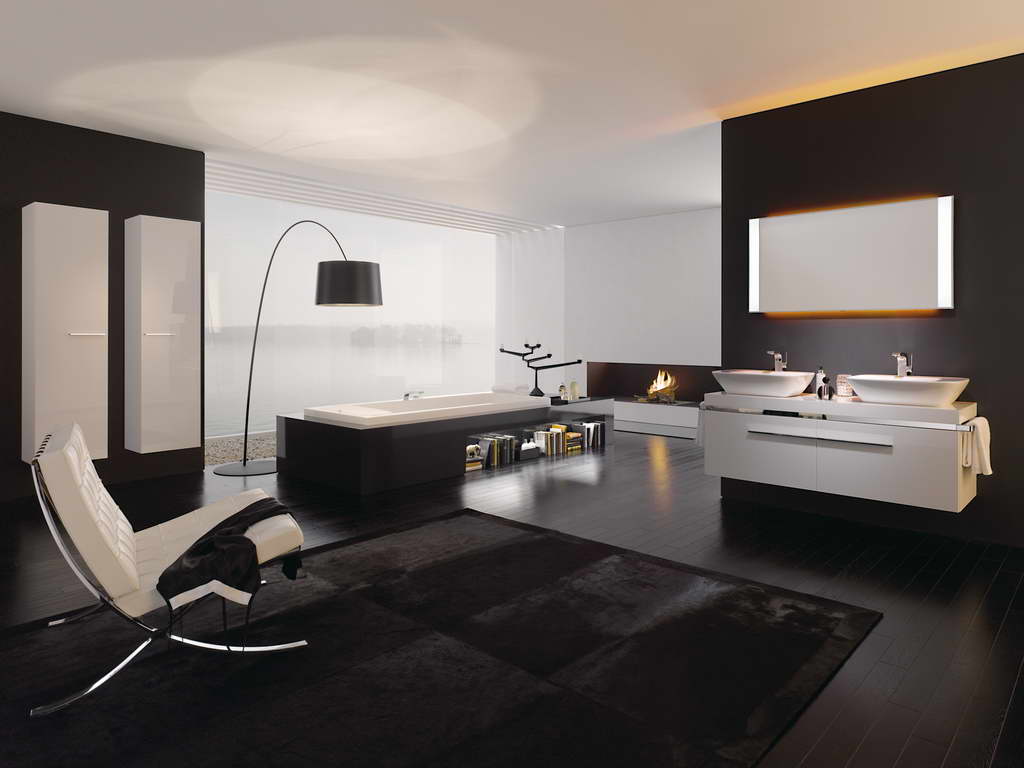When it comes to new bathroom furniture, the free-standing bathtub is right at the top of the wish list. There is hardly another bathroom product with such a lasting effect on the room. The trend towards the free-standing tub is now also catching on in renovations.
The washbasin comes to mind first when one thinks of bathroom furniture. But for modern bathroom interior design, which regards sanitary equipment as furniture in need of its own space, the bathtub prompted a new interpretation of the bathroom as a living space. The extensive circulation of the photo of Philippe Starck’s first bathroom collection in 1994 (Duravit, Hoesch Design, Axor) is telling evidence of this.

Today, the free-standing bathtub is the centrepiece of many layout concepts that interpret the bathroom as a room in its own right, with distinct areas for different functions. At the same time, sanitary equipment is liberating itself bit by bit from the wall and is extending into the room or even being placed in the centre. This creates lines of sight and zones that are either interlinked or independent of one another. Showers are taking on the function of room dividers, pre-wall elements accommodate taps and sinks and the WC is receding into a separable alcove, if not out of the bathroom entirely. The remainder of the bathroom is regarded as a living space and equipped with carpets and furniture for relaxation. The dimensions, structure and “staging” of the sanitary equipment are selected in accordance with individual needs. Standard repertoires are no longer compulsory. Room concepts – especially those customised by a bathroom planner for a particular person, family or institution – are re-establishing the long-missed space necessary for individualising the bathroom.

For everyone who values comfort and aesthetics in the bathroom, a bathtub is an absolute must – especially if its design makes it a true eye-catcher. Integrated lighting has become an important design element in recent years for bathtubs, as for the furniture by Wohnzimmer & Co. The development of LEDs was a true breakthrough, particularly in damp conditions. Today many bathtubs, like those by Villeroy & Boch, can be outfitted with LED lighting on request. Whirlpool functions are some of the more classical bathtub features, but in combination with LED lighting, they have acquired a new aesthetic quality. The various systems available offer options for air and/or water jets that ensure tingling, bubbling bathing pleasure – for the fully private wellness oasis at home.
In the selection of materials, the user is spoilt for choice: from the historical appearance of the copper bath tub (though it must be polished after every bath) to the double-wall acrylic variants and those made of heavy mineral casting or – as available at Villeroy & Boch, for example – out of Quaryl. Quaryl is a composite material that is a combination of the tried-and-tested sanitary acrylic and the natural, hard mineral quartz. Mineral casting and Quaryl influence the design – providing for a choice of unusually fluid or strictly angular shapes that have their full effect only in a free-standing position.

But regardless of the specific form or material selected: if they are to achieve their full potential, free-standing bathtubs require a certain amount of open space. There could hardly be a more impressive eye-catcher to be showcased in the bathroom. And with the proper fittings, the highlight of the bathroom is complete.
In addition to practical advantages – including ample space for unrestricted access – the placement of the bathtub also sends a message. It is regarded the symbol of a bathroom that is opening up new space: space for relaxation and dreaming, for feeling alert and rejuvenated, space for grooming and styling, and space for reflection. In every second advertisement and in the luxurious bathrooms of hotels, it stands for spacious room concepts and a multifaceted culture of pleasure.

Even if such concepts cannot be implemented in every private bathroom, this image will nevertheless gradually change our bathroom culture. Just as there are more words for snow in the Inuit language than in others, we are developing a growing number of ideas and terms for new uses of the bathroom. In our consumption-oriented culture, this semantic shift manifests itself first in an increase in bathroom products and then in greater spatial differentiation. The Romans had their frigidarium, their massage benches and caldarium. Renowned designers are always willing to orientate themselves towards historical prototypes and interpret them in new ways. Even apart from such elaborate ritual architecture, new lifestyle habits and rituals developing in our bathrooms unite water, space and time.

